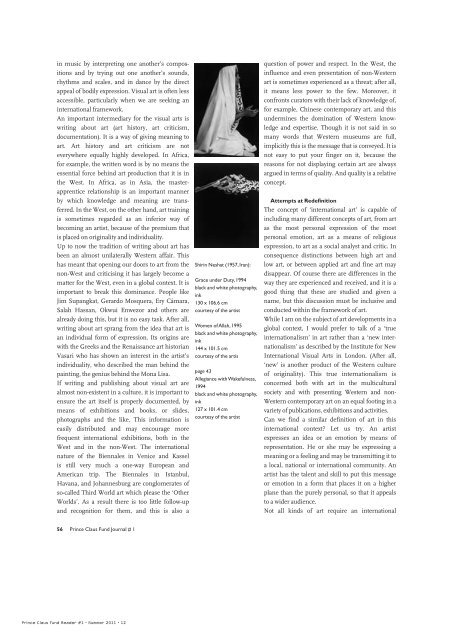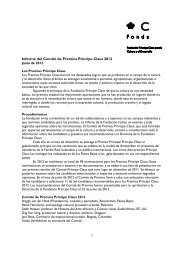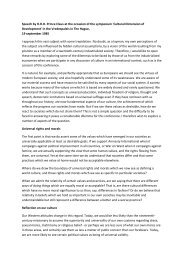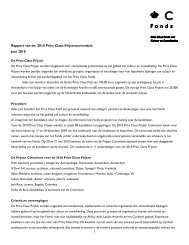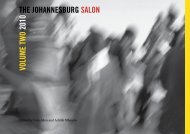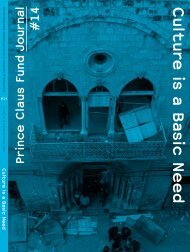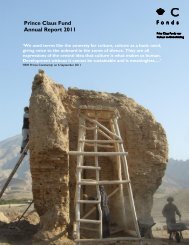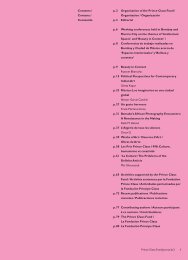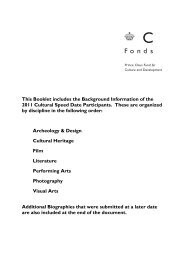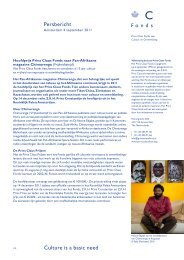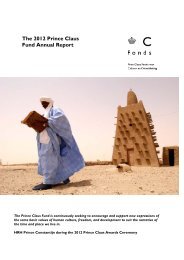3 summer 2011 - Prince Claus Fund
3 summer 2011 - Prince Claus Fund
3 summer 2011 - Prince Claus Fund
- No tags were found...
You also want an ePaper? Increase the reach of your titles
YUMPU automatically turns print PDFs into web optimized ePapers that Google loves.
in music by interpreting one another’s compositionsand by trying out one another’s sounds,rhythms and scales, and in dance by the directappeal of bodily expression. Visual art is often lessaccessible, particularly when we are seeking aninternational framework.An important intermediary for the visual arts iswriting about art (art history, art criticism,documentation). It is a way of giving meaning toart. Art history and art criticism are noteverywhere equally highly developed. In Africa,for example, the written word is by no means theessential force behind art production that it is inthe West. In Africa, as in Asia, the masterapprenticerelationship is an important mannerby which knowledge and meaning are transferred.In the West, on the other hand, art trainingis sometimes regarded as an inferior way ofbecoming an artist, because of the premium thatis placed on originality and individuality.Up to now the tradition of writing about art hasbeen an almost unilaterally Western affair. Thishas meant that opening our doors to art from thenon-West and criticising it has largely become amatter for the West, even in a global context. It isimportant to break this dominance. People likeJim Supangkat, Gerardo Mosquera, Ery Cámara,Salah Hassan, Okwui Enwezor and others arealready doing this, but it is no easy task. After all,writing about art sprang from the idea that art isan individual form of expression. Its origins arewith the Greeks and the Renaissance art historianVasari who has shown an interest in the artist’sindividuality, who described the man behind thepainting, the genius behind the Mona Lisa.If writing and publishing about visual art arealmost non-existent in a culture, it is important toensure the art itself is properly documented, bymeans of exhibitions and books, or slides,photographs and the like. This information iseasily distributed and may encourage morefrequent international exhibitions, both in theWest and in the non-West. The internationalnature of the Biennales in Venice and Kasselis still very much a one-way European andAmerican trip. The Biennales in Istanbul,Havana, and Johannesburg are conglomerates ofso-called Third World art which please the ‘OtherWorlds’. As a result there is too little follow-upand recognition for them, and this is also aShirin Neshat (1957, Iran):Grace under Duty, 1994black and white photography,ink130 x 106.6 cmcourtesy of the artistWomen of Allah, 1995black and white photography,ink144 x 101.5 cmcourtesy of the artispage 43Allegiance with Wakefulness,1994black and white photography,ink127 x 101.4 cmcourtesy of the artistquestion of power and respect. In the West, theinfluence and even presentation of non-Westernart is sometimes experienced as a threat; after all,it means less power to the few. Moreover, itconfronts curators with their lack of knowledge of,for example, Chinese contemporary art, and thisundermines the domination of Western knowledgeand expertise. Though it is not said in somany words that Western museums are full,implicitly this is the message that is conveyed. It isnot easy to put your finger on it, because thereasons for not displaying certain art are alwaysargued in terms of quality. And quality is a relativeconcept.Attempts at RedefinitionThe concept of ‘international art’ is capable ofincluding many different concepts of art, from artas the most personal expression of the mostpersonal emotion, art as a means of religiousexpression, to art as a social analyst and critic. Inconsequence distinctions between high art andlow art, or between applied art and fine art maydisappear. Of course there are differences in theway they are experienced and received, and it is agood thing that these are studied and given aname, but this discussion must be inclusive andconducted within the framework of art.While I am on the subject of art developments in aglobal context, I would prefer to talk of a ‘trueinternationalism’ in art rather than a ‘new internationalism’as described by the Institute for NewInternational Visual Arts in London. (After all,‘new’ is another product of the Western cultureof originality). This true internationalism isconcerned both with art in the multiculturalsociety and with presenting Western and non-Western contemporary art on an equal footing in avariety of publications, exhibitions and activities.Can we find a similar definition of art in thisinternational context? Let us try. An artistexpresses an idea or an emotion by means ofrepresentation. He or she may be expressing ameaning or a feeling and may be transmitting it toa local, national or international community. Anartist has the talent and skill to put this messageor emotion in a form that places it on a higherplane than the purely personal, so that it appealsto a wider audience.Not all kinds of art require an international56 <strong>Prince</strong> <strong>Claus</strong> <strong>Fund</strong> Journal # 1<strong>Prince</strong> <strong>Claus</strong> <strong>Fund</strong> Reader #1 · Summer <strong>2011</strong> · 12


